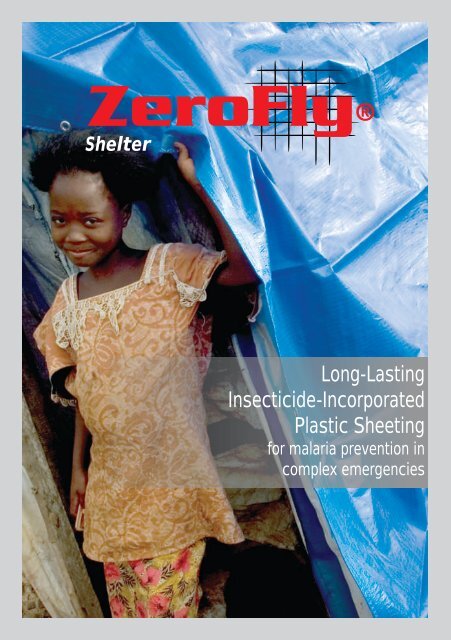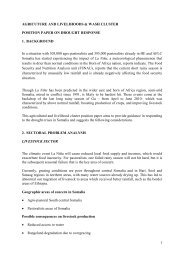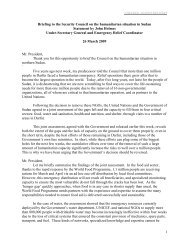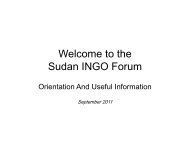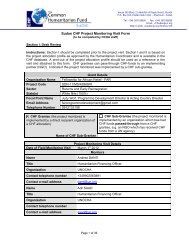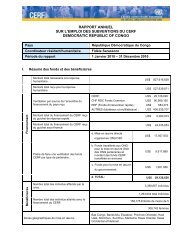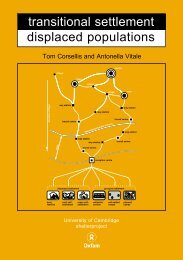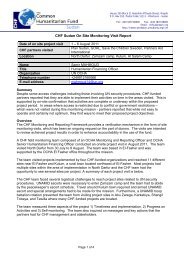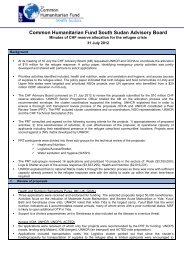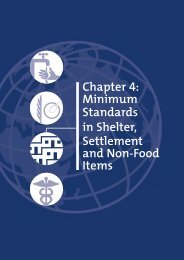Brochure Zerofly - OCHANet
Brochure Zerofly - OCHANet
Brochure Zerofly - OCHANet
- No tags were found...
You also want an ePaper? Increase the reach of your titles
YUMPU automatically turns print PDFs into web optimized ePapers that Google loves.
ShelterLong-LastingInsecticide-IncorporatedPlastic Sheetingfor malaria prevention incomplex emergencies
1Plastic sheeting is among thefirst of aid articles to bedistributed to refugees inemergency situations. Whenplastic sheeting is equippedwith vector control abilities, itbecomes a highly efficienthealth improvement tool.
The ZeroFly® ConceptOne third of the world´s annual malaria deaths occuramongst populations affected by conflicts in Sub-Saharan Africa. Malaria may account for between 50and 90 percent of all outpatient consultations and over50 percent of deaths, particularly during the acute1emergency phase .The acute stage of emergencies, when people are themost vulnerable, may last for several months. In thesesituations, when international organisations are themain provider of essential services, the focus is onl i fe s aving o p e rations. D i s e a s e p re ve ntioninterventions tend to be implemented at a much laterstage or not at all. Resources, time and operationalconstraints reduce the suitability of availableprevention strategies such as insecticide-treated netsand residual spraying used for malaria control. As aconsequence, malaria remains largely unaddressed incomplex emergencies.To bridge the gap between the acute phase of anemergency and the time when proper infrastructure isestablished, the ZeroFly® shelter, a long-lastinginsecticide-incorporated plastic sheeting, has beendeveloped as a dual function tool providing bothshelter and malaria prevention.Using ZeroFly® shelter as a malaria-control tool has thefollowing advantages: Emergency shelter material such as plasticsheeting is often the first thing on the ground, andmalaria prevention therefore begins immediately. In acute emergency situations with high deathrates, the priorities of the displaced families focuson the most tangible issues related to survival,such as food, water and shelter, which increase thelikelihood of use and retention. Malaria prevention is provided with an increasedspeed of response and cost-effectiveness sinceinsecticide is incorporated into a product beingsent into the field.ZeroFly® shelter is a preventive interventiondeveloped by Vestergaard Frandsen to change thehealth management of the most vulnerable people onearth — the displaced.1WHO report. 2002. Capacity building for Roll Back Malaria in Complex Emergencies 2
3The circumstances of a complexemergency undermine any pre-existingmalaria control measures and lead to acollapse of health services. Populationmovements and displacement,increased vulnerability due tomalnutrition and concurrent infections,poor or absent housing, poorcoordination among health agencies,and environmental deteriorationresulting in increased vector breeding allcontribute to the increased malariaburden. As a result, people becomemore vulnerable to malaria attacks,severe malaria and death from malaria.– World Health Organization
5®ZeroFly Shelter also protectsusers against weather andprovides privacy.
Product OverviewZeroFly® ShelterIs a long-lasting insecticide-incorporated plastic sheeting, which remains effective for up to oneyearIs a single solution to the dual needs for shelter and protection against vector-borne disease incomplex emergenciesInsecticide continuously migrates to the surface, which makes it highly effective against diseasevectors, such as mosquitoes carrying the malaria parasiteCan be used to construct temporary shelter, latrines, hospitals and schoolsIs cost-effective as a malaria prevention tool, as insecticide is incorporated directly into aproduct that is often the first intervention in complex emergenciesSaves delivery time for malaria control as shelter is often the first thing on ground, thus reducingthe dependency on specialised control teamsIs highly valued by refugees, as plastic sheeting is essential for shelter and survivalWhen used on a large scale in a town or refugee camp, the product creates a ‘mass effect’ thatbrings down the density of pathogen-transmitting vectors in that areaHas a black centre weave, which ensures opacity and thus privacy to the user6
Working PrincipleZeroFly® Shelter is constructed of a woven centre fabric, with lamination on both sides. Insecticide is incorporated inthe woven centre fabric.The insecticide will over time migrate through the laminates to the surface of the plastic sheeting, giving the productvector control abilities. In the lamination there are several UV protectors, some of which protect the insecticide andothers that protect the plastic material.In the lamination there are chemicals that control the migration of the insecticide, leading to a slow release andsecuring an adequate concentration of insecticide on the surface at all times.The UV protectors that protect the insecticide have the ability to migrate with the insecticide to prevent degradationthroughout the migration process.7
UV Protection System UV protection system with dual action Protects the plastic material Protects the insecticideInsecticide with Migration Inhibitors The natural migration speed of insecticideis too fast Migration inhibitors reduce the speed ofmigration Result is “controlled release”Insecticide Migrating from Centre WeaveInsecticide is stored in the centre weaveInsecticide migrates to the surface whenneededIs well protected against sunlightProlongs active period of the shelter for up to9–12 months8
9ZeroFly® Shelter was distributedto the internally displacedpopulation of Aceh after the regionwas hit by a devastating tsunami inDecember 2004.
Technical SpecificationsItem Requirement Test StandardBasic specificationConstructionCentre fabricCoating/ laminationReinforced borders and/ or eyeletsEyeletsMaterialPlacementReinforcementMaterialborderMaterial specificationHDPE flat yarns, wovenMesh size: target at 14 x 14 yarns per inchColour: BlackLDPE filmColour: Blue (on both sides)Aluminium or non-rusting steelOne in each corner and one per metre ±5% on all foursides. The eyelets are mounted in the fold3 mm diameter cordSize 4 x 5 metres ± 5%Insecticide(Deltamethrin)2.5 g/kg ± 25% CIPAC 333, modifiedBio-efficacyMin. 80% Functional Mortality (Fm24) or min. 95%Knockdown (KD60), tested with susceptibleAnopheles gambiae and Aedes aegyptiWHO Guideline 2005.112Weight 200 g/m ± 5% ASTM D 3776, option C or ISO 3801Tensile strength Min. 600 N ISO 1421, Grab testTearing strength Min. 100 N ISO 13937-3 (wing shaped)UV resistanceTemperatureresistanceFire resistancePrinting/ LabellinglabelLogoFabricationMarkingsPrinting/ Packing LabellingSheetsShipping volumeStorageStorage conditionShelf lifeMaximum 5% loss of original tensile strength aftera minimum of 1500 hours radiated under ASTMG53/94 (UVB313 nm peak)ZeroFly® performs well in the range of -20°C to80°C based on the basic material of polyethylene.Test is not required.ASTM G53/94ISO 1421Flashpoint min. 200°C CPAI 84-1995 section 6Optional test: shall not igniteOn requestBatch code, month, year of productionMarking every tarpISO 6940, exposed to a test flame for 10sEach sheet is packed in a plastic bag. Ten (10) sheets are packed in a bale. Each bale is wrapped in a wovenbag. Bale is compressed with straps on each direction.Min. 2800 pcs in a 20’ containerStore in dark, dry and cool conditionMinimum 2 years10
Evidence of the Impact of Insecticide-Treated PlasticSheeting/ Tarpaulins and TentsInsecticide-treated plastic tarpaulins for control of malaria vectors in refugee campsReferenceObjectiveKey FindingsConclusionGraham K. et al. 2002. Medical and Veterinary EntomologyTo compare the insecticidal efficacy of plastic tarpaulin sprayed with deltamethrin on its2inner surface (target dose 30mg/m ), tarpaulin impregnated with deltamethrin (initially >230mg/m ) during manufacture, and a tent made from the factory impregnated tarpaulinmaterial.Laboratory and field experiments confirm a level of efficacy near 100% for ZeroFly® plasticsheeting. In refugee camps where coverage is high, the prospect for malaria control wouldremain high due to the mass killing effect of vector mosquitoes.Insecticide-treated plastic sheeting has potential as a wider public health tool againstvarious vector-borne diseases in refugee camps.The indoor use of plastic sheeting pre-impregnated with insecticide for control of malaria vectorsReferenceObjectiveKey FindingsConclusionDiabate A. et al. 2006. Tropical Medicine and International HealthTo evaluate the efficacy of pyrethroid-treated plastic sheeting (ITPS) applied as a lining tothe ceiling or walls of rooms against pyrethroid-susceptible and pyrethroid-resistantAnopheles gambiae.ITPS had a major effect on the mortality of mosquitoes, the proportion killed beingdependent upon the surface area covered. Homozygotes for kdr resistance showed lowerrates of mortality than did heterozygotes or homozygotes for susceptibility. Deterredentry of mosquitoes and inhibition of blood feeding were also correlated with surface areacovered. The mode of action and efficacy of ITPS seems to bear closer resemblance to thatinduced by indoor residual spraying (IRS) than to that induced by insecticide-treated nets.ITPS might be conceived as being equivalent to long-lasting or permanent IRS but withoutsome of the operational constraints normally associated with spraying. High coverage ofITPS could potentially have a mass population effect on mosquitoes and give rise to longtermcommunity protection against malaria.11
Tents pre-treated with insecticide for malaria control in refugee camps: an entomological evaluationReferenceObjectiveKey FindingsConclusionGraham K. et al. 2004. Malaria JournalTo evaluate the entomological efficacy of tents made of untreated canvas withdeltamethrin-treated polyethylene threads interwoven through the canvas duringmanufacture (from which ZeroFly® is constructed).The insecticide-treated tents were effective both in killing mosquitoes and reducingblood-feeding. Mean 24 hour mortality was 25.7% on untreated tents and 50.8% ontreated tents in wild anophelines and 5.2% on untreated tents and 80.9% on treated tentsin insectary-reared Anopheles stephensi. Blood-feeding of wild anophelines was reducedfrom 46% in the presence of an untreated tent to 9.2% in the presence of treated tents andfrom 51.1% to 22.2% for insectary-reared An. stephensi. In contact bioassays on tentsweathered for three months there was 91.3% mortality after 10-minute exposure and a 24h holding period and 83.0% mortality after 3-minute exposure and a 24 h holding period.The use of pyrethroid-treated tents is already established as a malaria controlintervention. A technology that enables tents to be pre-treated with insecticide duringmanufacture and be shown to retain insecticidal efficacy for up to one year would improvethe feasibility of malaria control during the acute stage of an emergency.12
Field Evaluation of ZeroFly® Long-lastingInsecticide-treated Plastic SheetingSierra Leone Camp-Scale Trial 2 locations Multi-year Vector control Malaria parasitaemia reduction Health impactLargo Refugee CampTobanda Refugee CampA study conducted in Sierra Leone where two large communities of displaced persons were provided with ZeroFly®Shelter demonstrated the performance value and high user acceptance of this technology for malaria vector control.The use of ZeroFly® in such complex emergency settings will allow for rapid coverage of the at-risk population whilereducing logistics involved with camp spray programs.13
Mosquito Collections; Largo Refugee Camp(Internal lining of plastic) (N=288)During the dry season thenumber of mosquitoesobtaining a blood meal wasconsiderably less insections of the camp wheredisplaced persons livedunder ZeroFly® Shelterversus untreated plasticsheeting.No. Anopheles Spp.250200150100500Endophilic Resting Catches(n=70)(ITPS=7.1% of Total Collections)Human Landing Catches(n=218)(ITPS=4.6% of Total Collections)ITPSDry Season: Nov - Mar (Pre-Exposure ITPS 5-9 months)ITPS was used on the roof as well as all the wallsUPSMosquito Collections; Tobanda Refugee Camp(Internal lining of plastic) (N=872)CDC Light Trap Collections (n=234)The positive effect ofZeroFly® Shelter in reducingmosquito density, hostlocating numbers, andsuccessful blood feedingcontinued even during thewet season 10-14 monthsafter the shelters wereinstalled in the refugeecamp.No. Anopheles Spp.300250200150100500Endophilic Resting Catches(n=299)(ITPS=13.4% of Total Collections)Human Landing Catches(n=339)(ITPS=15.6% of Total Collections)ITPSUPSWet Season: Apr - Oct (Pre-Exposure ITPS 10 - 14 months)ITPS was used only on the roof14
Summary of Laboratory TrialsTen samples of ZeroFly® plastic sheeting wererandomly taken from production – five samples each ingreen, white and blue colours. The samples wereevaluated on the following parameters:Dimension and visual checkPhysical properties (tensile and tearing strength)Chemical properties (retention of deltamethrin)BioefficacyFire resistanceZeroFly® plastic sheeting meets the technicalspecifications set for all the above.The bioefficacy of ZeroFly® was evaluated againstAedes aegypti using the WHO cone test. The belowfigure shows the increasing functional mortality (FM)verses time, indicating deltamethrin migration in thelamination. The bioefficacy of the product reachesalmost 100% shortly after production. ZeroFly® plasticsheeting meets the requirements of the WHO conetest, with 30 minutes contact time.Bioefficacy development after production120Functional Mortality - FM 24 (%)10080604020010091952 weeks100 100964 weeks6 weeksGreenBlueWhiteMinimum accepted level16
Quality ControlVestergaard Frandsen maintains quality controlstandards necessary to meet WHOPES specifications.We have our own internal laboratories complying withWHO protocol. This ensures real time monitoring ofquality.Quality Control samples of ZeroFly® plastic sheeting aretaken randomly from production, coded uniquely andallotted a reference number, which is quoted in everypurchase order.The QC sample is sent to QC laboratories for testing, themethodology of which is described below:Master Batch (MB): Before the start of production ofeach lot of ZeroFly®, a five gram sample is extractedfrom both the ZeroFly® Low Density Polyethylene(LDPE) and the ZeroFly® High Density Polyethylene(HDPE) lots.Central Weave (CW): Just after weaving, three samples2of approximately 0.25 m (50cm x 50cm) are taken eachtime after completion of approximately 10,000 squaremetres of fabric. The first sample is at least 100 metresfrom the beginning of the roll and the other two atrandom thereafter. All the samples must fall within twometre range on the roll.Lamination/ finished product: After lamination, a fullwidth sample of approximately two metres length istaken at the position where the CW samples weretaken. This piece should contain both samples of thefinished product and the lamination samples at theplaces where the CW samples were taken.Coding/ labelling: Coding/ labelling of samples isdone as per SOP S.01.Dispatch of samples: Immediately after extractingthe sample after lamination, all correspondingsamples are packed independently and sent to thelaboratory for analysis.Handling of samples at the laborator y :Subsequently, the laboratory assigns parallel codes tothe lamination and the finished product samplesaccording to SOP S.01.Reporting: Results of the chemical analysis from thelaboratory are sent to Vestergaard Frandsen’sproduction database and if deviations from thespecifications sheet occur, then the results are sent tothe production manager.Storage of samples: Reference samples are stored fora period of five years with full history at roomtemperature, for future reference.Chemical analysis: Samples sent for chemical analysisare used to determine the pass/ fail status of theproduction. The methods analyse the totalconcentration of deltamethrin on the ZeroFly®tarpaulin. The method is described in the SOP.C.02.1.Certificate of QualityEach shipment of ZeroFly® plastic sheeting isaccompanied with a Certificate of Quality (COQ).COQ summarises Quality Control testing data,including physical properties, chemical properties,dimension check, visual check, marking andpacking for every batch or shipment.18
Application, safe handling, transportation and useAdvisory Note (October 2004)Potential Applications:ZeroFly® is a plastic sheeting designed as a dual purpose tool for shelter construction and insect-borne diseasecontrol. It incorporates the slow release of Deltamethrin, which migrates gradually to both surfaces of theexposed plastic sheeting.Deltamethrin is a WHO-recommended insecticide that is commonly used for the impregnation of mosquitonets and for indoor residual spaying. It controls mosquitoes, house flies and other insects by contact andingestion.ZeroFly®, when used as the inner and/ or outer wall of a shelter, may help to control mosquitoes that bite andrest indoors. This works in a similar way to indoor residual spraying. When used as the outer surface of a shelter,or latrine, this material will help to control insects which prefer to rest on the outside of shelters, such as houseflies.Maximum insect control will be achieved when the total inside and outer surface area of the shelter, or latrine, ismade of this material. Used in this way significant protection from malaria may be achieved for the occupantswho sleep under the shelter. Where ZeroFly® is used only for roofing material of shelters (and not walls) this maybe beneficial for insect control but is unlikely to provide adequate malaria control alone and should be used inconjunction.Safe Handling and Transportation:Deltamethrin is recommended by WHO for use in malaria control materials. It has low human toxicity risk whencombined with materials such as ZeroFly®. Independent safety tests recently conducted on ZeroFly® show thatit is both safe to use as shelter material and has no significant accumulative effect in humans, rain water, or soilwhen used in these applications.Skin contact with deltamethrin can cause skin irritation. When transporting, storing, or using this material forshelter/ latrine construction: Avoid children handling the materials where possible. Ensure all users wear PVC, or other, protective gloves for handling the material. Wear full clothing to minimise any skin contact. Ensure that soap and water are always available for all people handling this material. Advise shelteroccupants to minimise direct contact with the material once construction is completed. Use of ZeroFly® for food storage or as a surface for food preparation by camp residents is not appropriate andshould be actively discouraged.19
First AidSymptoms from exposure to deltamethrin will generally be short lasting and will normally wear off in a fewhours.In the event of breathing difficulty place the person in fresh air. If symptoms persist seek medical attention.If skin irritation occurs, remove any contaminated clothes and wash skin (and clothes) thoroughly with soap.If irritation of the eyes occurs then flush the eyes with large amounts of clean water. Seek medical attention ifirritation persists.This MENTOR Initiative advisory note does not imply, in any way,endorsement of this, or other, commercial products.Please refer to www.rbm.who.int for further information.20
Handling InstructionsDosDon’tsWear protective gloves while handling theplastic sheeting.Minimise direct contact with the plasticsheeting after it has been installed.Wear full clothing to minimise any skincontact.The Plastic Sheeting should not come intocontact with food as contamination canoccur.Wash hands and other exposed body partswith soap and clean water.21
References of UsageMore than 200,000 ZeroFly® Shelters have been sent toprotect IDPs in Sudan, Sierra Leone, Madagascar,Liberia, DRC, Gambia, Haiti, Sri Lanka, India andIndonesia. To mention a few:Indonesia (2005/ 2006)In Aceh (tsunami), over 20,000 ZeroFly® plasticsheetings were used to provide emergency shelter forover 100,000 IDPs; and in the Java earthquake, over17,000 ZeroFly® plastic sheetings were used tore-construct houses, schools and clinics.India (2005)70,000 victims of the Kashmir earthquake weresheltered and protected with ZeroFly® Shelter.Liberia (2003-2005)13,000 Liberian IDPs were housed in two camps inLiberia by The Mentor Initiative.Findings from a survey conducted by The MentorInitiative in Indonesia: ITPS proved feasible to use on varied Indonesianshelter/ house designs 82% people said that ITPS had a significant impacton insects of all types 94% reported no incidence of malaria or denguewhilst living under ITPSSierra Leone (2003- 2005/6)14,000 Liberian refugees were housed in two camps inSierra Leone by The Mentor Initiative.73% said that they would be happy to live underITPS again22
Logistics and Customer SupportDeliveryVestergaard Frandsen works with a multitude of localpartners to provide the exceptional service of deliveringproducts to in-country destinations rather than simplyshipping them to the container port, as is the case withmost other suppliers. We have developed a distributionnetwork across the African continent, establishingdelivery channels for deeper penetration inland andensuring a seamless delivery to the end destination.WarehousingVestergaard Frandsen has warehouse facilities in theremotest parts of the world, allowing the company tohelp programme implementers distribute ZeroFly®Shelter affordably and efficiently.Global Customer SupportWith 11 regional offices across Africa, Asia, Europe andthe Americas, Vestergaard Frandsen provides anexceptional local and international customer service.Being close to the market is an unequivocal benefit forour customers and partners, allowing rapid andproactive service and market intelligence.This unique profile makes Vestergaard Frandsen theoptimal partner for disease control needs.23
Customer Support OfficesHead OfficeVestergaard Frandsen Group S.A.Chemin de Messidor 5 - 7CH 1006, LausanneSwitzerlandTel. : +41 (0) 21 310 7333Fax : +41 (0) 21 310 7330E-mail : hq@vestergaard-frandsen.comRegional Office (the Americas)Vestergaard Frandsen Inc.2300 Clarendon Boulevard,Suite 603, Arlington, VA 22201USATel. : +1 571 527 2180Fax : +1 703 997 3235E-mail : usa@vestergaard-frandsen.comRegional Office (South Africa)Vestergaard Frandsen (SA) (Proprietary) Ltd.Edenberg Terraces, 348 Rivonia Boulevard Rivonia,2nd Floor, Block C, PostNet Suite # 37,Private Bag X51,Rivonia, 2128, Johannesburg, South AfricaTel : +27 11 807 2191Fax : +27 11 807 2312E-mail : southafrica@vestergaard-frandsen.comRegional Office (Central Africa)Vestergaard Frandsen Nigeria Ltd.Heidelberg House, 2nd Floor38/40 Association Avenue, Ilupeju, LagosNigeriaTel. : +234 1 761 2692 / +234 1 743 3576E-mail : nigeria@vestergaard-frandsen.comRegional Office (South Asia)Vestergaard Frandsen (India) Pvt. Ltd.309, Rectangle One, Saket,New Delhi - 110017IndiaTel. : +91 11 4055 3666Fax : +91 11 4055 3500E-mail : india@vestergaard-frandsen.comRegional Office (Middle East)Vestergaard Frandsen Middle East JLTUnit 1501, Jumeirah Business Center 2Jumeirah Lakes Towers, P.O. Box 214354, DubaiUnited Arab EmiratesTel. : +971 (0) 4 368 1321 / 1322Fax : +971 (0) 4 368 1323E-mail : dubai@vestergaard-frandsen.comRegional Office (East Africa)Vestergaard Frandsen (EA) Ltd.Waiyaki Way, ABC Place,P.O. Box 66889 - 00800, NairobiKenyaTel. : +254 20 4444 758 / 9Fax : +254 20 4444 526E-mail : kenya@vestergaard-frandsen.comRegional Office (West Africa)Vestergaard Frandsen West Africa Ltd.15 Josiah Tongogara StreetLabone, AccraGhanaTel. : +233 (0) 21 775 781 / 776 442Fax : +233 (0) 21 776 914E-mail : ghana@vestergaard-frandsen.comRegional Office (Central Africa)Vestergaard Frandsen Nigeria Ltd.4th Floor, Orji Uzor Kalu House, 1st Avenue,Off Ahmadu Bello Way, Central Business District, AbujaNigeriaTel. : +234 (0) 9 781 8651/ +234 (0) 9 874 8490E-mail : nigeria@vestergaard-frandsen.comRegional Office (Western Pacific)PT Vestergaard Frandsen IndonesiaWisma Nusantara, 12th Floor,Jl. M H Thamrin 59, Jakarta - 10350,IndonesiaTel. : +62 21 3913930Fax : +62 21 3913931E-mail : indonesia@vestergaard-frandsen.comCommunications OfficeVestergaard Frandsen New York100 Park Avenue, 16th Floor,New York, NY 10017USATel. : +1 212 984 1026E-mail : media@vestergaard-frandsen.com24
Product code - ZFBE01www.zerofly.comZeroFly® is a registered trademark of Vestergaard Frandsen SA.


